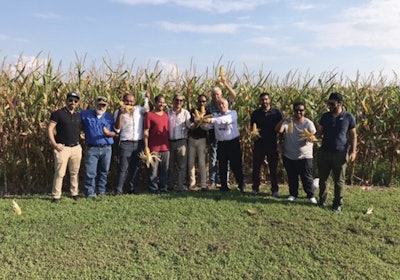
The Middle East and North Africa region is highly competitive with a rapidly changing market environment and considerable long-term growth potential. Over the past year, the U.S. Grains Council (USGC) has shifted the focus of some programs in the region to respond to new market opportunities, while continuing to deploy the same long-term market development strategies proven over the course of decades to transform these opportunities into long-lasting markets for U.S. coarse grains and co-products.
Shifting dynamics driving growing demand
Home to 17 countries and 371 million people, the Middle East and North Africa represents a complex and vast geographic area. The U.S. Department of Agriculture (USDA) projected the region will account for more than half of the growth in world coarse grain imports through 2026, driven by rising incomes and populations fostering strong demand for livestock products.
Regional imports from the United States have continued to grow over the past five years from 98 million bushels in the 2013/2014 marketing year to 315 million bushels in 2016/2017. The Council projects the region will be a 394 million bushel market for U.S. coarse grains in all forms at the end of the current marketing year, worth more than $1.8 billion.
The Council has focused on being flexible and responsive in the region, supported by a regional office in Tunisia and consultants in Turkey, Pakistan, Morocco, Algeria, Egypt, Saudi Arabia and Jordan.
Middle East and Africa Director Ramy Taieb and Manager of Global Trade Alvaro Cordero joined me in highlighting the importance of this market during the Council’s 58th Annual Membership Meeting in Denver, CO, in July.
Together, the panel discussed how supply and demand factors set the stage for growth in U.S. distiller’s dried grains with solubles (DDGS) and corn exports to Middle East and North Africa markets. Shifting trade dynamics, including China’s recent purchases of Ukrainian corn, have increased the price of Black Sea grains and increased the competitive position of U.S. corn in the region. As a result, countries in the Middle East and North Africa that typically purchase Black Sea corn are switching to U.S. origin.
Developing MEA market strategies
Maintaining existing partnerships and building new relationships with importers, government officials and respected organizations is paramount to the long-term strategy for the Council’s work in the Middle East and North Africa region.
The Council’s staff and consultants actively work on those interactions through activities like the Global Grain MENA Conference in June in the United Arab Emirates. The event included major international grain companies, stakeholders and grain importers and feed millers from the United Arab Emirates, Egypt, Lebanon, Turkey, Saudi Arabia, Jordan, Pakistan and Oman.
The conference allowed the Council to promote U.S. corn, sorghum and co-products to stakeholders throughout the region, including key market players, influential traders and proven Council partners. Cordero presented on the outlook for sorghum and DDGS in the region as well as how U.S. exporters are adapting to increasing competition in the global marketplace.
Activities such as this conference are important opportunities to promote U.S. corn co-products, which no other competitors can export in significant quantities, and highlight the marketing advantages of the U.S. export system, which include transparency, timeliness, reliability and excellent quality. All of these factors work together to maximize the U.S. competitive advantage.
Capitalizing on opportunities in Saudi Arabia
Years of work by Council staff and members set the stage with local customers to capture near-term opportunities in the region over the past few marketing years. This market development work is exemplified in the Saudi Arabian market. A combination of favorable government policy changes, shifting trade dynamics and highly competitive U.S. export prices have resulted in significant demand growth opportunities in Saudi Arabia for not only U.S. corn, but also U.S. sorghum, DDGS, corn gluten feed/meal and ethanol. Saudi Araba represents an expanding market, driven by concerns about water security, rising income levels and population — all of which is leading to growing imports.
Traditionally, Egypt has been the largest buyer of U.S. corn in the Middle East; however, Saudi Arabia took the top spot in 2015/2016.
The Kingdom purchased 82 million bushels of U.S. corn valued at $358 million in 2016/2017, a 150% growth over the previous marketing year and ranking as the seventh largest overseas buyer of U.S. corn. It has also ramped up purchases of U.S. ethanol substantially over the last two marketing years, with 2.5 million gallons sold in 2016/2017 plus 25,600 tons of U.S. DDGS.
The steep increase in purchases of U.S. coarse grains and co-products year-over-year has not been replicated in 2017/2018, with the exception of ethanol, but sales of U.S. corn, DDGS and other co-products remain above the five-year average and on track to meet or exceed 2015/2016 sales.
本地政策刺激了这些变化史fts. In 2011, the Saudi government added 14 new feed ingredients to the national animal feed subsidy program, the major driving force behind the feed grains, co-products and forages imported by the Saudi feed, livestock and poultry industries. That new list includes U.S. DDGS and corn gluten feed/meal, opening the door for imports, with the Council’s market education efforts playing an essential role in making this decision happen.
A second policy shift in 2016 began the phase-out of domestic wheat production in order to help conserve Saudi Arabia’s limited water resources. The policy ends a 30-year program for irrigating domestic wheat production and bodes well for increased U.S. exports of corn and co-products.
While demand potential in Saudi Arabia is very large, it requires extensive market development work. The Saudi dairy industry is one of the most modern in the world, and the country’s large poultry industry processes fresh product for domestic use as well as for export to neighboring Gulf countries. These industries are quick to adopt new technology and ideas, but they are still relatively unfamiliar with U.S. corn co-products.
To address these constraints, the Council sponsored a Saudi buyer team to the biannual Export Exchange in October 2016, timed perfectly with the U.S. corn harvest. As a result, the participants reported buying 76,000 tons of corn and DDGS valued at $13 million and set the stage for the growing purchases of corn, sorghum and co-products witnessed now.
In 2017, the Council continued these efforts in August by bringing key feed grain importers and end-users to Illinois, Virginia and Louisiana to see firsthand U.S. feed grain production as well as meet face-to-face with U.S. suppliers and exporters. The team also learned more about how grain moves through the logistics channels for export markets, quality preservation throughout the supply chain, quality assurance by the U.S. Federal Grain Inspection Service (FGIS), best buying practices and contract specifications.
Through these activities, the Council is building long-term Saudi confidence in food security through trade and long-term relationships to maintain strong exports.
Seizing short-term opportunities for U.S. sorghum
The Council’s farsighted approach for watching as policy shifts and market trends unfold and establishing relationships with key market players also plays an important role in capitalizing on short-term opportunities when they arise — as was the case with U.S. sorghum in spring 2018.
Twenty vessels of U.S. sorghum were in route to China when the country suddenly announced an immediate 178.6% preliminary anti-dumping duty on U.S. sorghum on April 18, 2018.
The Council’s global staff immediately went to work — fielding calls by members and international customers looking for alternative markets for these sorghum shipments.
The Saudi Arabian market is no stranger to U.S. sorghum. The Council regularly brings teams of Saudi buyers to the United States to learn more about U.S. sorghum production, quality and logistics.
This previous groundwork in Saudi Arabia allowed the Council to spring into action and capitalize on the buying opportunity for U.S. sorghum by Saudi buyers. Cordero and Taieb were on the ground in Saudi Arabia the very week the new tariff was announced. The pair immediately engaged with Saudi buyers to discuss the distressed sorghum vessels and how U.S. sorghum could help meet Saudi Arabia’s growing feed demand.
After the meetings in April, four Panamax shipments of U.S. sorghum, equaling about 280,000 tons (11 million bushels), were re-routed to Saudi Arabia. Two shipments of U.S. sorghum arrived at Saudi ports on May 5.
The Council is engaged in ongoing market education and outreach efforts on sorghum, corn and DDGS exports to Saudi Arabia in the coming year, including a 10-member team invited to participate in the 2018 Export Exchange set for October in Minneapolis, Minnesota. The biennial conference is uniquely focused on connecting international grain buyers like the Saudi team with U.S. suppliers to further build and sustain connections in the grain trade.
Turning opportunities into long-term success
中东和北非地区been a challenging, but valuable market for U.S. coarse grains and co-products. The Council’s long history of engagement in the region will continue for years to come — seeking to explore short-term market opportunities to continue building long-lasting and successful partnerships with regional feed grain importers through trade as a win-win relationship. ❚




















